GMC SONOMA 2000 Owner's Manual
Manufacturer: GMC, Model Year: 2000, Model line: SONOMA, Model: GMC SONOMA 2000Pages: 381, PDF Size: 2.65 MB
Page 111 of 381
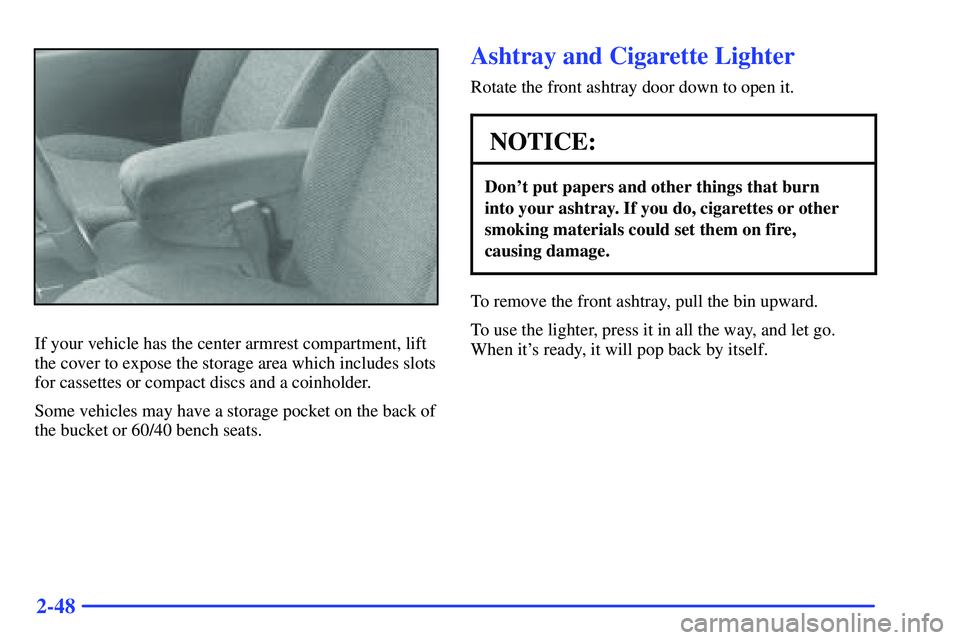
2-48
If your vehicle has the center armrest compartment, lift
the cover to expose the storage area which includes slots
for cassettes or compact discs and a coinholder.
Some vehicles may have a storage pocket on the back of
the bucket or 60/40 bench seats.
Ashtray and Cigarette Lighter
Rotate the front ashtray door down to open it.
NOTICE:
Don't put papers and other things that burn
into your ashtray. If you do, cigarettes or other
smoking materials could set them on fire,
causing damage.
To remove the front ashtray, pull the bin upward.
To use the lighter, press it in all the way, and let go.
When it's ready, it will pop back by itself.
Page 112 of 381
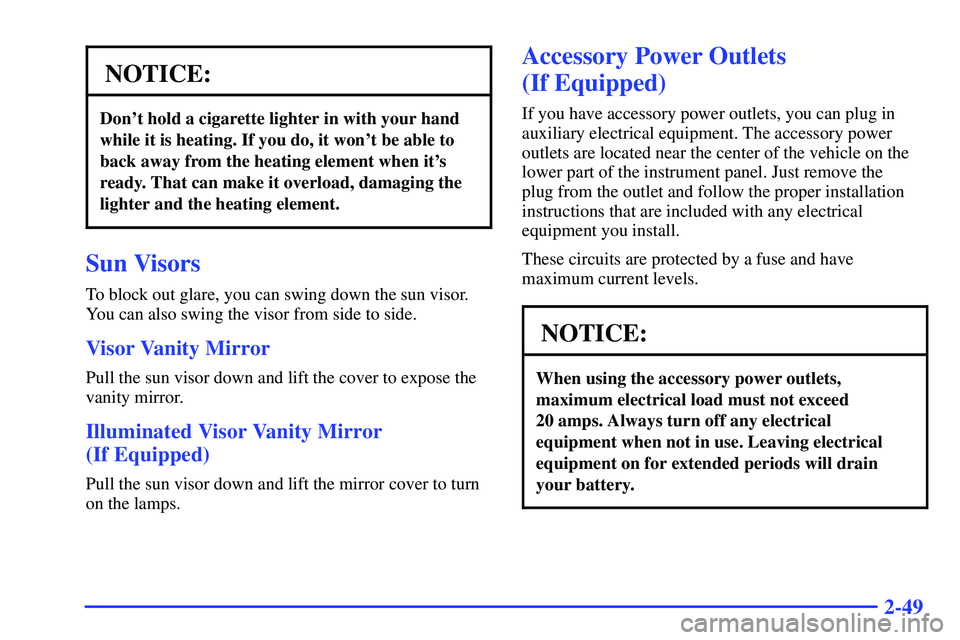
2-49
NOTICE:
Don't hold a cigarette lighter in with your hand
while it is heating. If you do, it won't be able to
back away from the heating element when it's
ready. That can make it overload, damaging the
lighter and the heating element.
Sun Visors
To block out glare, you can swing down the sun visor.
You can also swing the visor from side to side.
Visor Vanity Mirror
Pull the sun visor down and lift the cover to expose the
vanity mirror.
Illuminated Visor Vanity Mirror
(If Equipped)
Pull the sun visor down and lift the mirror cover to turn
on the lamps.
Accessory Power Outlets
(If Equipped)
If you have accessory power outlets, you can plug in
auxiliary electrical equipment. The accessory power
outlets are located near the center of the vehicle on the
lower part of the instrument panel. Just remove the
plug from the outlet and follow the proper installation
instructions that are included with any electrical
equipment you install.
These circuits are protected by a fuse and have
maximum current levels.
NOTICE:
When using the accessory power outlets,
maximum electrical load must not exceed
20 amps. Always turn off any electrical
equipment when not in use. Leaving electrical
equipment on for extended periods will drain
your battery.
Page 113 of 381
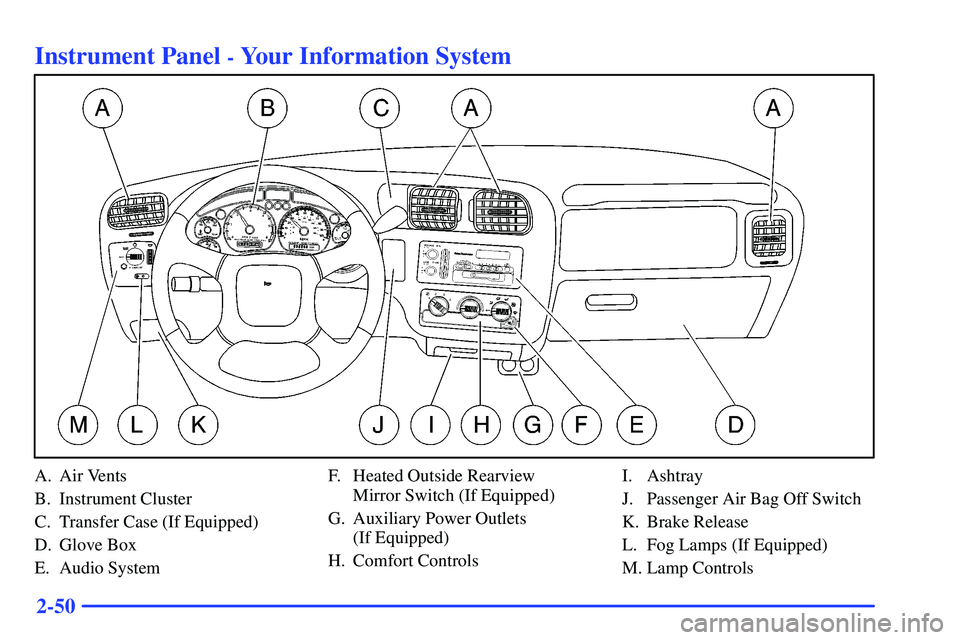
2-50
Instrument Panel - Your Information System
A. Air Vents
B. Instrument Cluster
C. Transfer Case (If Equipped)
D. Glove Box
E. Audio SystemF. Heated Outside Rearview
Mirror Switch (If Equipped)
G. Auxiliary Power Outlets
(If Equipped)
H. Comfort ControlsI. Ashtray
J. Passenger Air Bag Off Switch
K. Brake Release
L. Fog Lamps (If Equipped)
M. Lamp Controls
Page 114 of 381
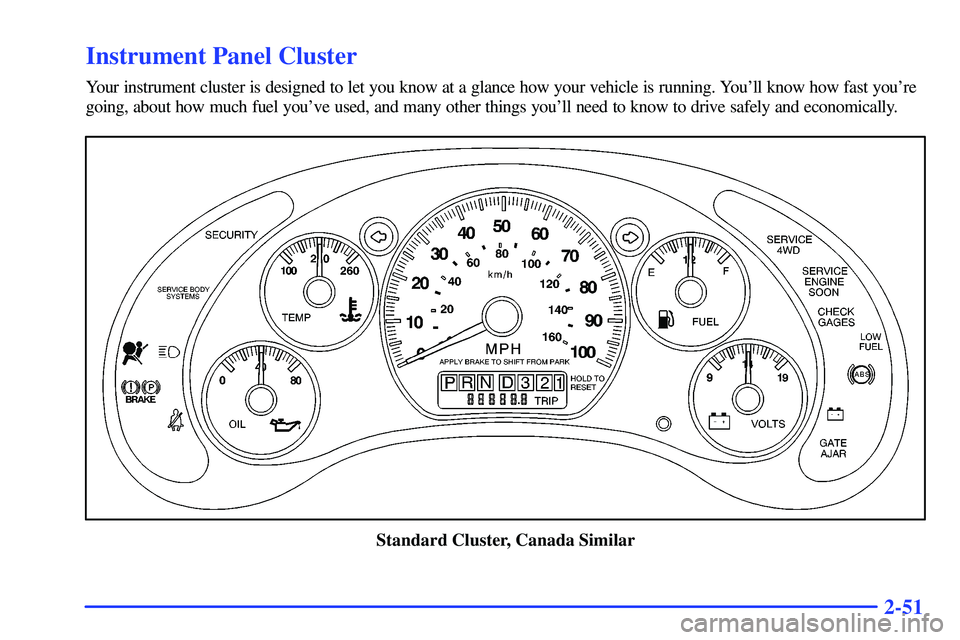
2-51
Instrument Panel Cluster
Your instrument cluster is designed to let you know at a glance how your vehicle is running. You'll know how fast you're
going, about how much fuel you've used, and many other things you'll need to know to drive safely and economically.
Standard Cluster, Canada Similar
Page 115 of 381
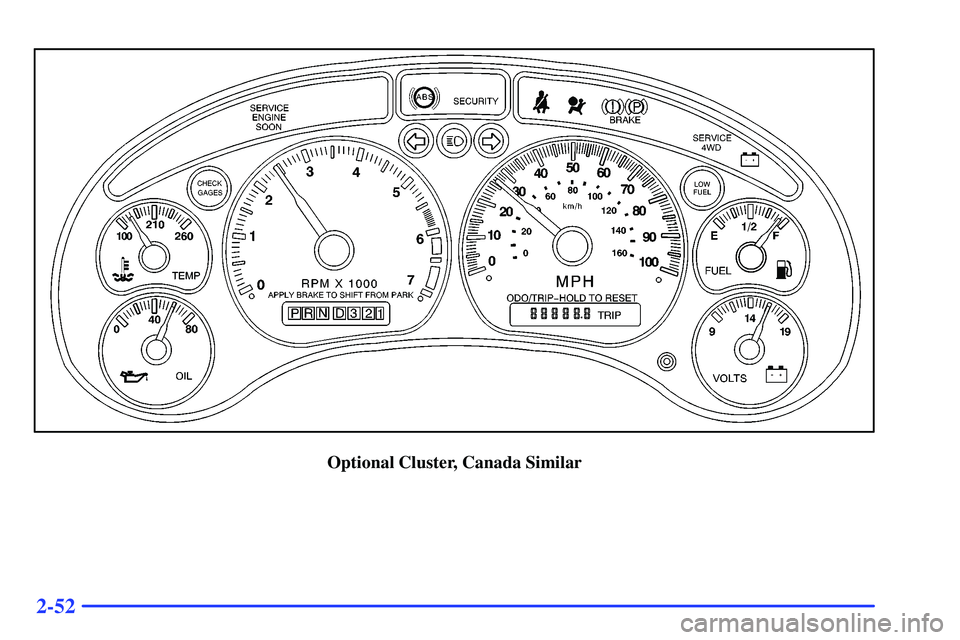
2-52
Optional Cluster, Canada Similar
Page 116 of 381
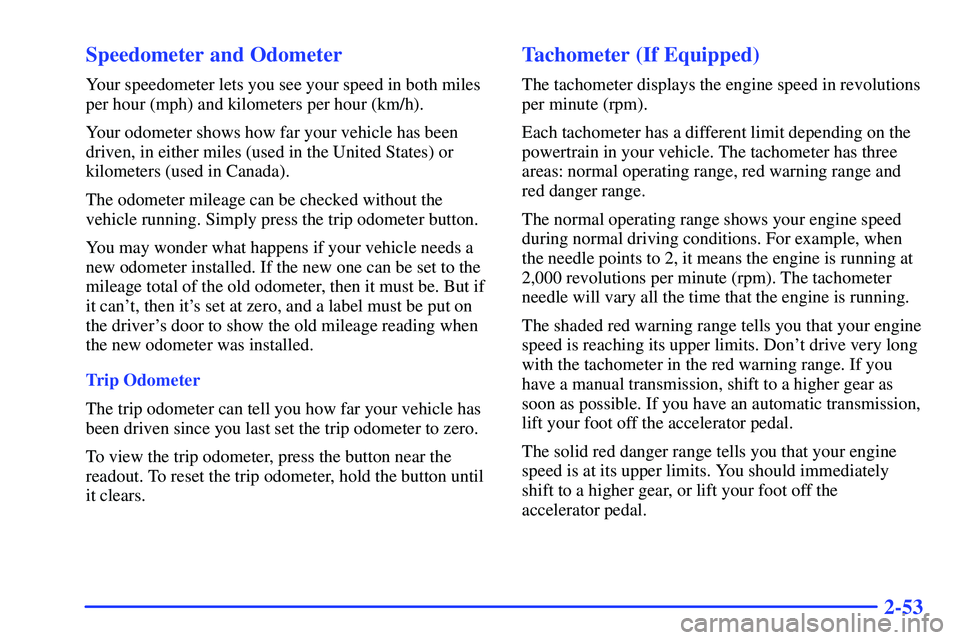
2-53 Speedometer and Odometer
Your speedometer lets you see your speed in both miles
per hour (mph) and kilometers per hour (km/h).
Your odometer shows how far your vehicle has been
driven, in either miles (used in the United States) or
kilometers (used in Canada).
The odometer mileage can be checked without the
vehicle running. Simply press the trip odometer button.
You may wonder what happens if your vehicle needs a
new odometer installed. If the new one can be set to the
mileage total of the old odometer, then it must be. But if
it can't, then it's set at zero, and a label must be put on
the driver's door to show the old mileage reading when
the new odometer was installed.
Trip Odometer
The trip odometer can tell you how far your vehicle has
been driven since you last set the trip odometer to zero.
To view the trip odometer, press the button near the
readout. To reset the trip odometer, hold the button until
it clears.
Tachometer (If Equipped)
The tachometer displays the engine speed in revolutions
per minute (rpm).
Each tachometer has a different limit depending on the
powertrain in your vehicle. The tachometer has three
areas: normal operating range, red warning range and
red danger range.
The normal operating range shows your engine speed
during normal driving conditions. For example, when
the needle points to 2, it means the engine is running at
2,000 revolutions per minute (rpm). The tachometer
needle will vary all the time that the engine is running.
The shaded red warning range tells you that your engine
speed is reaching its upper limits. Don't drive very long
with the tachometer in the red warning range. If you
have a manual transmission, shift to a higher gear as
soon as possible. If you have an automatic transmission,
lift your foot off the accelerator pedal.
The solid red danger range tells you that your engine
speed is at its upper limits. You should immediately
shift to a higher gear, or lift your foot off the
accelerator pedal.
Page 117 of 381
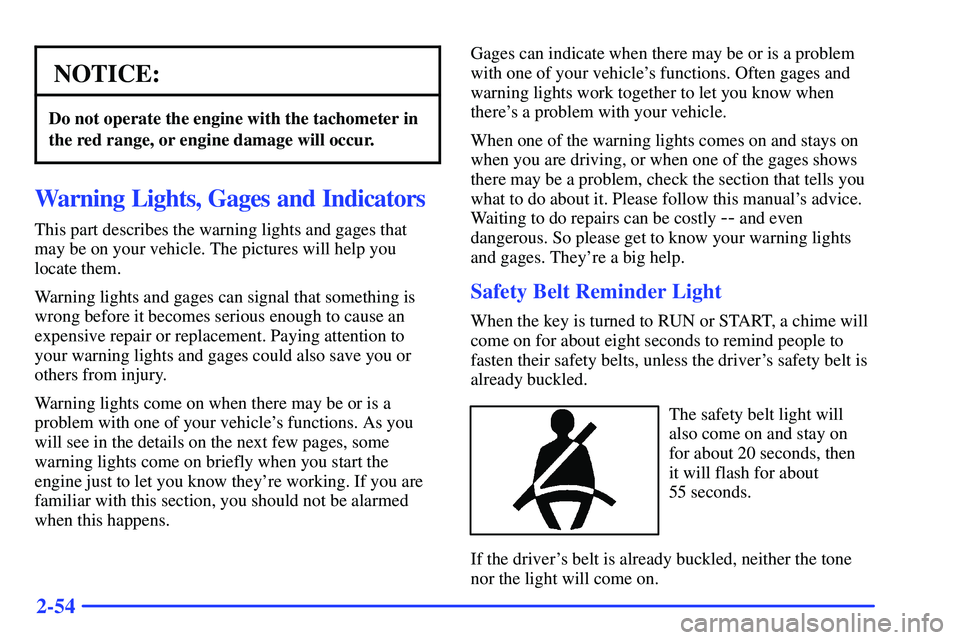
2-54
NOTICE:
Do not operate the engine with the tachometer in
the red range, or engine damage will occur.
Warning Lights, Gages and Indicators
This part describes the warning lights and gages that
may be on your vehicle. The pictures will help you
locate them.
Warning lights and gages can signal that something is
wrong before it becomes serious enough to cause an
expensive repair or replacement. Paying attention to
your warning lights and gages could also save you or
others from injury.
Warning lights come on when there may be or is a
problem with one of your vehicle's functions. As you
will see in the details on the next few pages, some
warning lights come on briefly when you start the
engine just to let you know they're working. If you are
familiar with this section, you should not be alarmed
when this happens.Gages can indicate when there may be or is a problem
with one of your vehicle's functions. Often gages and
warning lights work together to let you know when
there's a problem with your vehicle.
When one of the warning lights comes on and stays on
when you are driving, or when one of the gages shows
there may be a problem, check the section that tells you
what to do about it. Please follow this manual's advice.
Waiting to do repairs can be costly -- and even
dangerous. So please get to know your warning lights
and gages. They're a big help.
Safety Belt Reminder Light
When the key is turned to RUN or START, a chime will
come on for about eight seconds to remind people to
fasten their safety belts, unless the driver's safety belt is
already buckled.
The safety belt light will
also come on and stay on
for about 20 seconds, then
it will flash for about
55 seconds.
If the driver's belt is already buckled, neither the tone
nor the light will come on.
Page 118 of 381
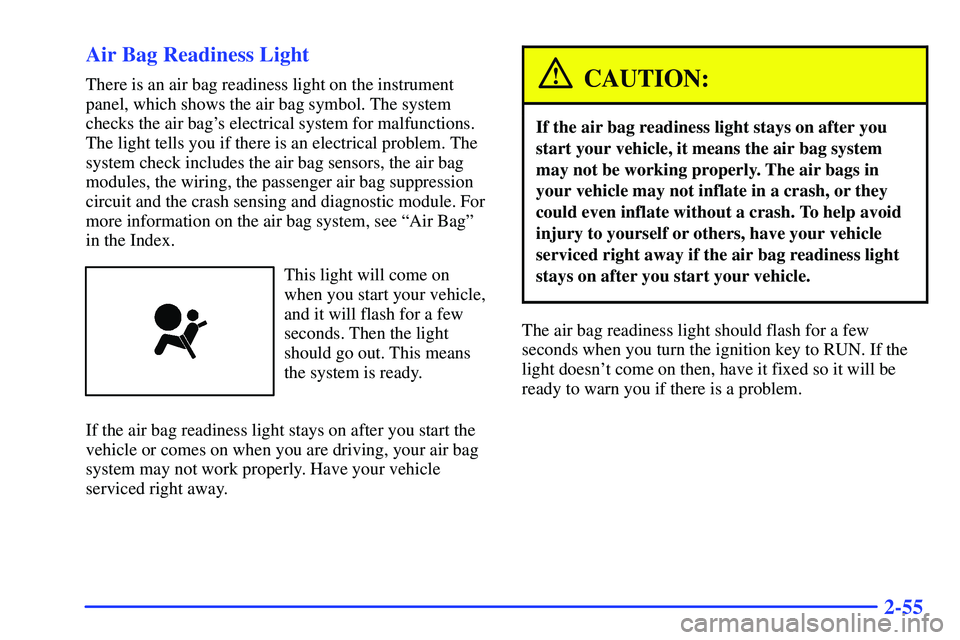
2-55 Air Bag Readiness Light
There is an air bag readiness light on the instrument
panel, which shows the air bag symbol. The system
checks the air bag's electrical system for malfunctions.
The light tells you if there is an electrical problem. The
system check includes the air bag sensors, the air bag
modules, the wiring, the passenger air bag suppression
circuit and the crash sensing and diagnostic module. For
more information on the air bag system, see ªAir Bagº
in the Index.
This light will come on
when you start your vehicle,
and it will flash for a few
seconds. Then the light
should go out. This means
the system is ready.
If the air bag readiness light stays on after you start the
vehicle or comes on when you are driving, your air bag
system may not work properly. Have your vehicle
serviced right away.
CAUTION:
If the air bag readiness light stays on after you
start your vehicle, it means the air bag system
may not be working properly. The air bags in
your vehicle may not inflate in a crash, or they
could even inflate without a crash. To help avoid
injury to yourself or others, have your vehicle
serviced right away if the air bag readiness light
stays on after you start your vehicle.
The air bag readiness light should flash for a few
seconds when you turn the ignition key to RUN. If the
light doesn't come on then, have it fixed so it will be
ready to warn you if there is a problem.
Page 119 of 381
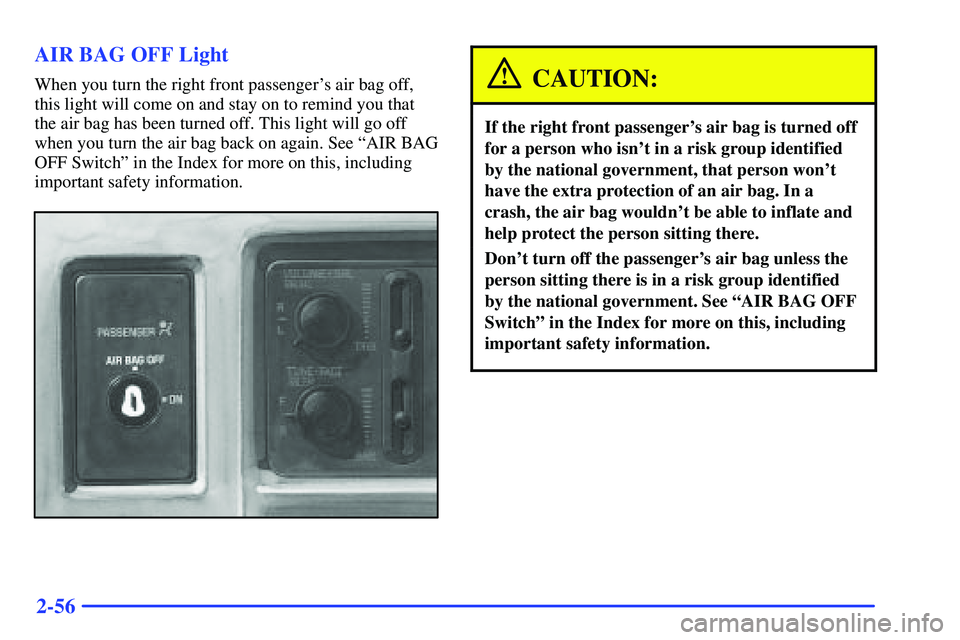
2-56 AIR BAG OFF Light
When you turn the right front passenger's air bag off,
this light will come on and stay on to remind you that
the air bag has been turned off. This light will go off
when you turn the air bag back on again. See ªAIR BAG
OFF Switchº in the Index for more on this, including
important safety information.CAUTION:
If the right front passenger's air bag is turned off
for a person who isn't in a risk group identified
by the national government, that person won't
have the extra protection of an air bag. In a
crash, the air bag wouldn't be able to inflate and
help protect the person sitting there.
Don't turn off the passenger's air bag unless the
person sitting there is in a risk group identified
by the national government. See ªAIR BAG OFF
Switchº in the Index for more on this, including
important safety information.
Page 120 of 381
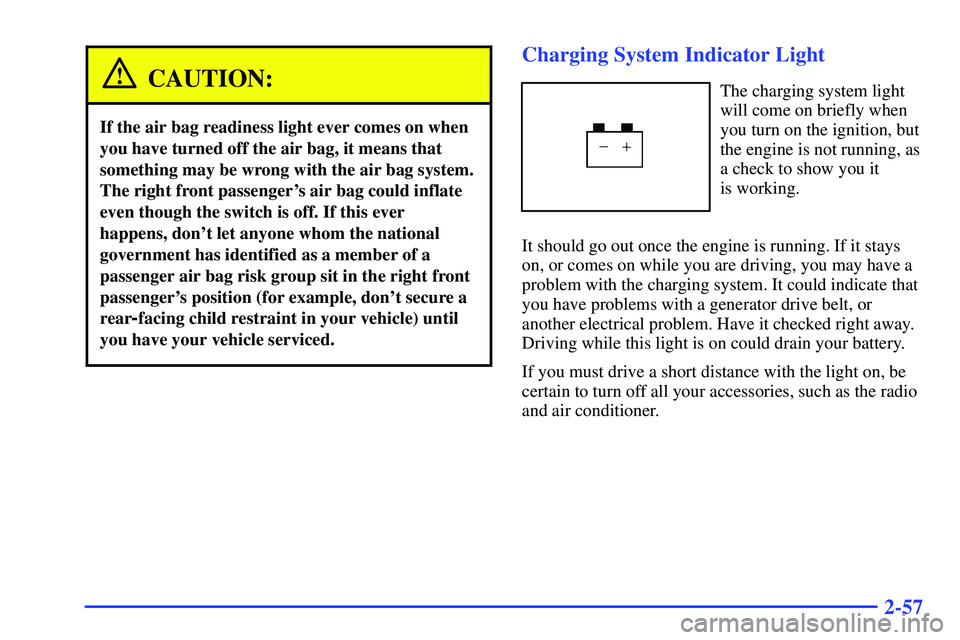
2-57
CAUTION:
If the air bag readiness light ever comes on when
you have turned off the air bag, it means that
something may be wrong with the air bag system.
The right front passenger's air bag could inflate
even though the switch is off. If this ever
happens, don't let anyone whom the national
government has identified as a member of a
passenger air bag risk group sit in the right front
passenger's position (for example, don't secure a
rear
-facing child restraint in your vehicle) until
you have your vehicle serviced.
Charging System Indicator Light
The charging system light
will come on briefly when
you turn on the ignition, but
the engine is not running, as
a check to show you it
is working.
It should go out once the engine is running. If it stays
on, or comes on while you are driving, you may have a
problem with the charging system. It could indicate that
you have problems with a generator drive belt, or
another electrical problem. Have it checked right away.
Driving while this light is on could drain your battery.
If you must drive a short distance with the light on, be
certain to turn off all your accessories, such as the radio
and air conditioner.